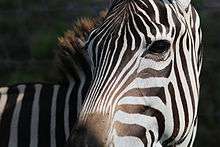Grant's zebra
| Grant's zebra | |
|---|---|
 | |
| Jacob's zebra (E. quagga boehmi) | |
| Scientific classification | |
| Kingdom: | Animalia |
| Phylum: | Chordata |
| Class: | Mammalia |
| Order: | Perissodactyla |
| Family: | Equidae |
| Genus: | Equus |
| Subgenus: | Hippotigris |
| Species: | E. quagga |
| Subspecies: | E. q. boehmi |
| Trinomial name | |
| Equus quagga boehmi Matschie, 1892 | |
Grant's zebra (Equus quagga boehmi) is the smallest of six subspecies of the plains zebra. This subspecies represents the zebra form of the Serengeti-Mara ecosystem.
Distribution
The distribution of this subspecies is in Zambia west of the Luangwa river and west to Kariba, Shaba Province of the Democratic Republic of the Congo, north to the Kibanzao Plateau. In Tanzania north from Nyangaui and Kibwezi into southwestern Kenya as far as Sotik. It can also be found in eastern Kenya and east of the Great Rift Valley into southernmost Ethiopia. It also occurs as far as the Juba River in Somalia.
Upper Zambezi zebras
Duncan (1992)[1] recognized the Upper Zambezi zebra (Equus quagga zambeziensis Prazak, 1898). Groves and Bell (2004)[2] came to the conclusion that the zebras from West Zambia and Malawi cannot be distinguished cranially and that they differ only slightly from other northern plains zebras. The rather minor size difference does not justify a separate sub-specific status for the Upper Zambezi zebra. Therefore, they combine these zebras with the Grant's zebra (Equus quagga boehmi).
Characteristics

This northern subspecies is vertically striped in front, horizontally on the back legs, and diagonally on the rump and hind flanks. Shadow stripes are absent or only poorly expressed. The stripes, as well as the inner-spaces, are broad and well defined. Northerly specimens may lack a mane. Grant’s zebras grow to be about 120 to 140 centimetres (3.9 to 4.6 ft) tall, and generally weigh about 300 kilograms (660 lb).[3] The zebras live in family groups of up to 17 or 18 zebras, and they are led by a single stallion. Grant’s zebras live an average of 20 years.
Regional extinctions
Recent civil wars in the Congo, Rwanda, Somalia, Sudan, Ethiopia, and Uganda have caused dramatic declines in all wildlife populations, including those of Grant’s zebra. It is now extinct in Burundi. Civil war in Angola during much of the past 25 years has devastated its wildlife populations, including its once-abundant plains zebra, and destroyed the national parks administration and infrastructure. Consequently, the Grant's zebra is probably extinct or nearly so in Angola, although confirmation will have to wait until future surveys are conducted.
There are more Grant’s zebras in the wild than any other species or subspecies of zebras. Unlike Grevy and Mountain zebras, they are not endangered.[4] Grant’s zebras eat the coarse grasses that grow on the African plains, and they are resistant to diseases that often kill cattle, so the zebras do well in the African savannas. However, recent civil wars and political conflicts in the African countries near their habitats has caused regional extinction, and sometimes zebras are killed for their coats, or to eliminate competition with domestic livestock.[3]
Gallery
-

Mother and foal in Lakeland, Florida
-
.jpg)
Near Chilanga, Zambia
-

Pregnant, Serengeti, Tanzania
References
- ↑ Duncan, P. (ed.). 1992.Zebras, Asses, and Horses: An Action Plan for the Conservation of Wild Equids. Gland, Switzerland: IUCN/SSC Equid Specialist Group.
- ↑ Groves, C.P. & Bell, H.B. 2004. "New Investigations on the Taxonomy of the Zebras Genus Equus, subgenus Hippotigris". Mammalian Biology. 69: 182-196.
- 1 2 "ANIMAL BYTES - Grant's Zebra". SeaWorld/Busch Gardens ANIMALS. SeaWorld Parks & Entertainment. Archived from the original on September 12, 2011.
- ↑ "Grant's Zebra". Honolulu Zoo. Archived from the original on September 12, 2011.
- Moelman, P. D. 2002. Equids: Zebras, Assess and Horses. Status Survey and Conservation Action Plan. IUCN/SSC Equid Specialist Group.)


